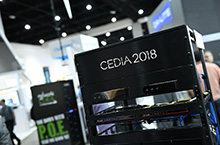Technology and Design

September 10, 2018

CEDIA Expo, the show all about the connected home experience, took place last week at the San Diego Convention Center. Between booth appointments and networking, KBB sat in on a seminar presented by Women in Consumer Technology that covered “The Impact of Technology on Lifestyle Design.”
The panel discussion was hosted by Toni Sabatino, Manhattan’s National Kitchen and Bath Association (NKBA) chapter president and a KBB editorial advisory board member. Panelists include Melissa Andresko, communications director, public relations, Lutron Electronics; Dawn DeLuca, founder and principal of New York City-based Dawn DeLuca On Design; and Heather Sidorowicz, owner and technologist of Southtown Audio Video.
The session explored everything from the evolution of lighting integration, network-enabled thermostats and home security systems to how technology is merging with the world of kitchen and bath. With the prevalence of whole-home solutions and the benefits of having smart appliances, the presence of technology in the kitchen and bath industry is only going to grow further.
According to DeLuca, consumers today want the same ease of use they see in their neighbor’s home and on TV in their own home but often fail to put in the investment of time necessary for that functionality. The client also needs to be educated and trained on how a system works and how to customize it further if necessary.
The key to successfully integrating a project with smart home capabilities and giving the client the tools and knowledge they need is hiring a smart home professional. Today, many smart home integration systems like Control4 or Seura offer this professional help with the purchase of their product, or designers can work hand-in-hand with a professional smart home installer.
“Home designers need to be educated about the value a technology professional can add as part of their team and create key partnerships to produce the best results for clients,” said Sabatino. “The client will benefit most from a team working together to create the ultimate living environment.”
To add a technology professional to the traditional design team, Sabatino recommends a new project process with these steps:
- Client hires an interior designer.
- The designer listens to the client’s needs and wants.
- The designer brings in a technologist partner to plan the networked solutions for entertainment, security, appliances and all devices in the home before they are installed.
- Designer and technologist work together on technology placement aesthetics and managing client expectations.
With the teamwork of these two types of professionals, the panel predicted that future projects will help solve everyday problems for every age group. This could range from time-saving cooking solutions for busy professionals, peace of mind in security for young parents and safety and comfort for seniors.
“We must start thinking differently as an industry,” said Sidorowicz. “Designing, building and equipping every home for technology is essential for our clients and the economy.”
More News
April 23, 2024 | Trends & Inspirations
Sustainability Report: More Education Needed for Green K&B Design
April 22, 2024 | Awards & Events, Trends & Inspirations
A Look Inside the 2024 Atlanta Homes & Lifestyles Southeastern Designer Showhouse
April 22, 2024 | KBB Collective
Top Designer Shares Favorite KBIS 2024 Products
April 22, 2024 | Trends & Inspirations
Survey: Nearly Half of Homeowners Invest in Green Plumbing
April 21, 2024 | Business
ADJ Interiors Moves Offices
April 2, 2024 | Sponsored
Whirlpool Corp. Brings Purposeful Innovation Home